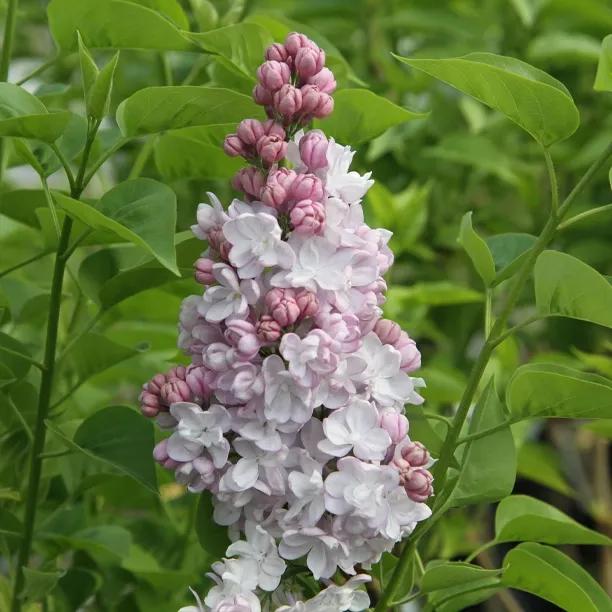Beauty of Moscow Lilac Plants
The details
Syringa vulgaris Beauty of Moscow
Pot Grown Plants- Height: 5m
- Spread: 3m
- Colour: pink in bud, then white
- Scent: strong and sweet
- Flowering: May - June
- Feature: heavenly fragrance
- Pot Grown: Year Round Delivery
Recommended extras
Description
Syringa Vulgaris 'Beauty of Moscow' Bushes
If you can imagine the pinkness of cheeks on a cold frosty morning you sort of have a picture of the buds of Beauty of Moscow Lilac. These then open into snowy double white flowers. The combination of tight, pink bud existing quietly with the joy of the pearly white flower is truly beautiful. As with all our lilacs the fragrance is heavenly and becomes noticeably stronger as the flowers mature. Beauty of Moscow flowers profusely in early to mid-May and the blooms last longer than most lilacs. The foliage is matt-green with a slightly heart shaped leaf. This shrub will flourish in any soil but prefers a neutral to alkaline pH if possible. In terms of maintenance, they just need dead heading as the flowers die so that you avoid looking at the faded, brown panicles and encourage more to come into flower. Beauty of Moscow is reasonably energetic and will grow into a large shrub of 10-12 feet high in ten years.
An icon for your garden
The Beauty of Moscow lilac is essential for the spring garden because it will give you an abundance of flowers at a time when flowering bulbs fade and the rest of the garden is yet to get into its summer stride. To extend the season, use the tree as a frame through which a viticella clematis can grow. Otherwise it will provide the perfect, matt green backdrop for other flowering shrubs or perennials like peonies, perowskias or hydrangeas. Looking like a miniature bouquet in its own right and with its exceptional smell, Beauty of Moscow makes a wonderful cut flower. Sear the stems in boiling water and leave it to soak overnight before arranging to ensure that the flowers last for as long as possible.
Features
- Height: 5m
- Spread: 3m
- Colour: pink buds, white flowers
- Scent: sweet and strengthens as matures
- Flowering: May - June
- Feature: heavenly fragrance
Did You Know?
The common lilac (Syringa vulgaris) originated in Eastern Europe as far back as the 15th century. By the 17th century, lilacs spread into Western Europe and with the help of early settlers eventually extended into North America. Cultivars were not actively bred until the 1800s when most of the hybrid activity occurred in the nurseries of Monsieur Lemoine in Nancy in France. Lilacs were immensely fashionable in Edwardian and Victorian times but fell out of favour when people looked to plants that needed to be 'doing' something over more than one season. Slowly many of the rarer types of lilac that had been bred in France by the Lemoine family became extinct but in Russia a lilac fanatic called Leonid Kolesnikov managed to cross-fertilise sterile double lilacs in the 1930s which secured him the post of head of the Soviet experimental breeding station for plants. It was Kolesnikov who bred Krasavitsa Moskvy from IV Michurin and Belle de Nancy in 1943 - a tribute to Moscow itself - and now one of the top twenty lilacs in the world. There are now about 150 Russian lilacs in accredited collections.
An amateur enthusiast, Colin Chapman, has tracked down as many as he can from all over the world and is cultivating 500 species, hybrids and cultivars in his garden near Stowmarket in Suffolk which is now the National Lilac Collection in the UK.


